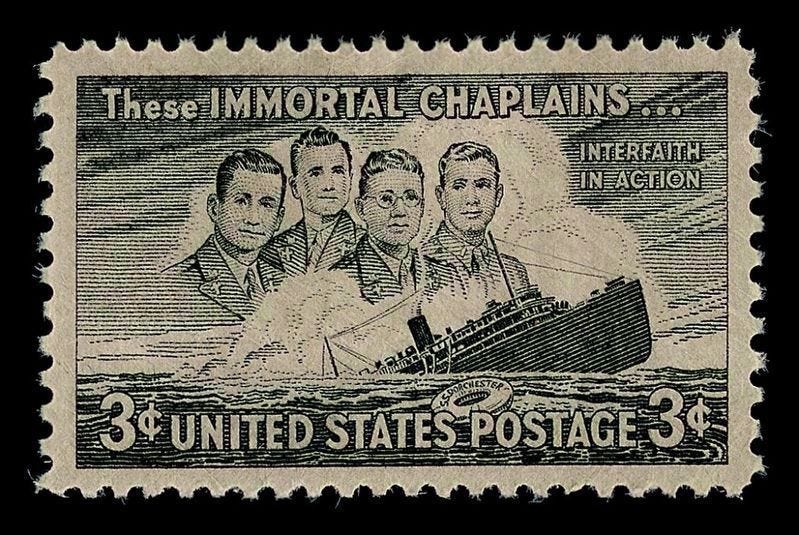Four Heroic Chaplains
While the story of the four chaplains may not be obscure or undiscovered — it was well-known by our parents and grandparents — it should not be forgotten.
When the army troopship Dorchester was torpedoed by a German U-boat and sank off the coast of Newfoundland in 1943, among the 674 lost lives were four chaplains: Father John P. Washington, Rabbi Alexander D. Goode, Rev. George L. Fox, and Rev. Clarke V. Poling.
Coast Guard and Navy ships sailing in the same convoy rescued 230 survivors. According to eyewitness survivors, these four chaplains - a Catholic, a Jew, and two Protestants - remained calm during the panic following the attack. They distributed life preservers and assisted others to abandon ship, finally giving up their own life preservers and coming together in prayer as the ship disappeared beneath the cold North Atlantic waters.
“The story of these four chaplains … stands out among the countless stories of commitment and bravery that make up the pantheon of the U.S. Army, as one of the finest examples of courage to God, man, and country. Each was drawn by the tragedy at Pearl Harbor to the armed forces.
“Each wanted more than anything else to serve God by ministering to men on the battlefield.
“Each felt great disappointment at being relegated to service in a rear area, in this case the airfields and installations of Greenland. Yet, each, when the moment came, did not hesitate to put others before self, courageously offering a tenuous chance of survival with the full knowledge of the consequences.”1
From sworn affidavits, here are some of those accounts, in the voices of survivors:2
“Up to the very last minute (the chaplains) continued with their mission of healing and comforting the terror stricken.” – Frank G. DiMeo
“I made for the life raft to which I was assigned and … passed four chaplains. … One of them possessed a life jacket and the other three did not. As I passed I noticed the chaplain with the life jacket remove his jacket and give it to a soldier … who did not have a life jacket. I overheard the soldier say, “Thank you, Chaplain.’” – Joseph D. Haymore
“They were passing out life preservers from boxes on deck. When these were gone, I saw them take the life preservers from their own persons and hand them out, too.” – Oswald R. Evans
“From my position as I clung to (a) lifeboat, I saw the chaplains clearly standing at the rail of the transport minus their life jackets, urging men to leave the ship with disregard to their own safety.” – William J. Pantall
(A)s I left the ship, I looked back and saw the chaplains … with their hands clasped, praying for the boys. They never made any attempt to save themselves, but they did try to save the others.” – Grady L. Clark
“I saw these chaplains without life preservers kneeling on deck and praying for us.” – Kenzel L. Linaweaver
“The last I saw of the chaplains they were standing on deck praying. By that time the ship had capsized and was at a forty-five-degree angle.” – Anthony J. Povlak
In 1944, each was posthumously awarded the Purple Heart and the Distinguished Service Cross. In 1948 the US Postal Service issued the commemorative stamp pictured above. In 1960 Congress created the Four Chaplains’ Medal, which was presented to their survivors by Secretary of the Army Wilber M. Brucker at Fort Myer, Virginia.
The entire story of the four chaplains may be found at the Army History website here. Take a look … and pass it on … there are lessons for us today - that’s the thing about history.
armyhistory.org
Rochester Beacon, May 28, 2021


